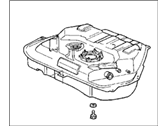×
- Hello
- Login or Register
- Quick Links
- Live Chat
- Track Order
- Parts Availability
- RMA
- Help Center
- Contact Us
- Shop for
- Honda Parts
- Honda Accessories

My Garage
My Account
Cart
Genuine Honda Del Sol Fuel Tank
Gas Tank- Select Vehicle by Model
- Select Vehicle by VIN
Select Vehicle by Model
orMake
Model
Year
Select Vehicle by VIN
For the most accurate results, select vehicle by your VIN (Vehicle Identification Number).
1 Fuel Tank found
Honda Del Sol Fuel Tank
In search of affordable OEM Honda Del Sol Fuel Tank? Consider browsing through our extensive inventory of genuine Honda Del Sol Fuel Tank. Not only do we provide market-leading prices and a manufacturer's warranty, but we also pride ourselves on exceptional customer service and swift delivery.
Honda Del Sol Fuel Tank Parts Questions & Experts Answers
- Q: Is the procedure for removing a fuel tank easier when the tank is empty, and what steps should be taken if there is no drain plug on Honda Del Sol?A:The procedure is much easier to perform if the fuel tank is empty, and some tanks have a drain plug for this purpose. If there is no drain plug, fuel can be siphoned using a siphoning kit available at most auto parts stores, but starting the siphoning action with your mouth is not advisable. Begin by removing the fuel tank filler cap to relieve pressure, then relieve the fuel system pressure. Detach the cable from the negative terminal of the battery. If the tank has a drain plug, remove it and drain the fuel into an approved gasoline container; if not, siphon the fuel into an approved container. Next, remove the rear seat and disconnect the fuel gauge and Fuel Pump electrical connectors. Raise the rear of the vehicle and secure it on jackstands, then remove the splash panels that protect the fuel tank and fuel lines. Label and disconnect the fuel hoses and any securing brackets, supporting the fuel tank with a floor jack and placing a wood block between the jack head and the tank for protection. Disconnect both fuel tank retaining straps and pivot them down until they are out of the way, then remove the tank from the vehicle. Installation is the reverse of removal.










